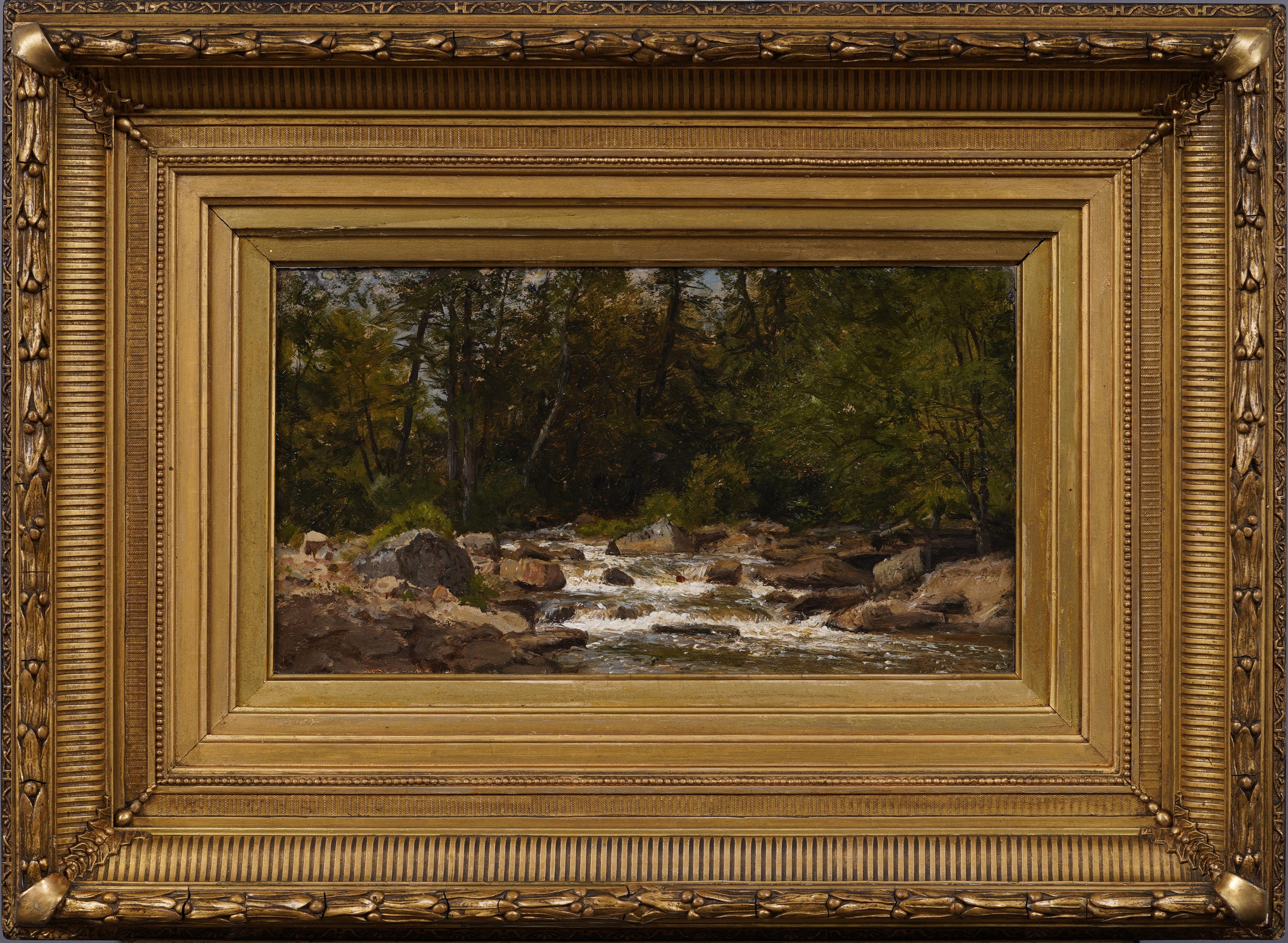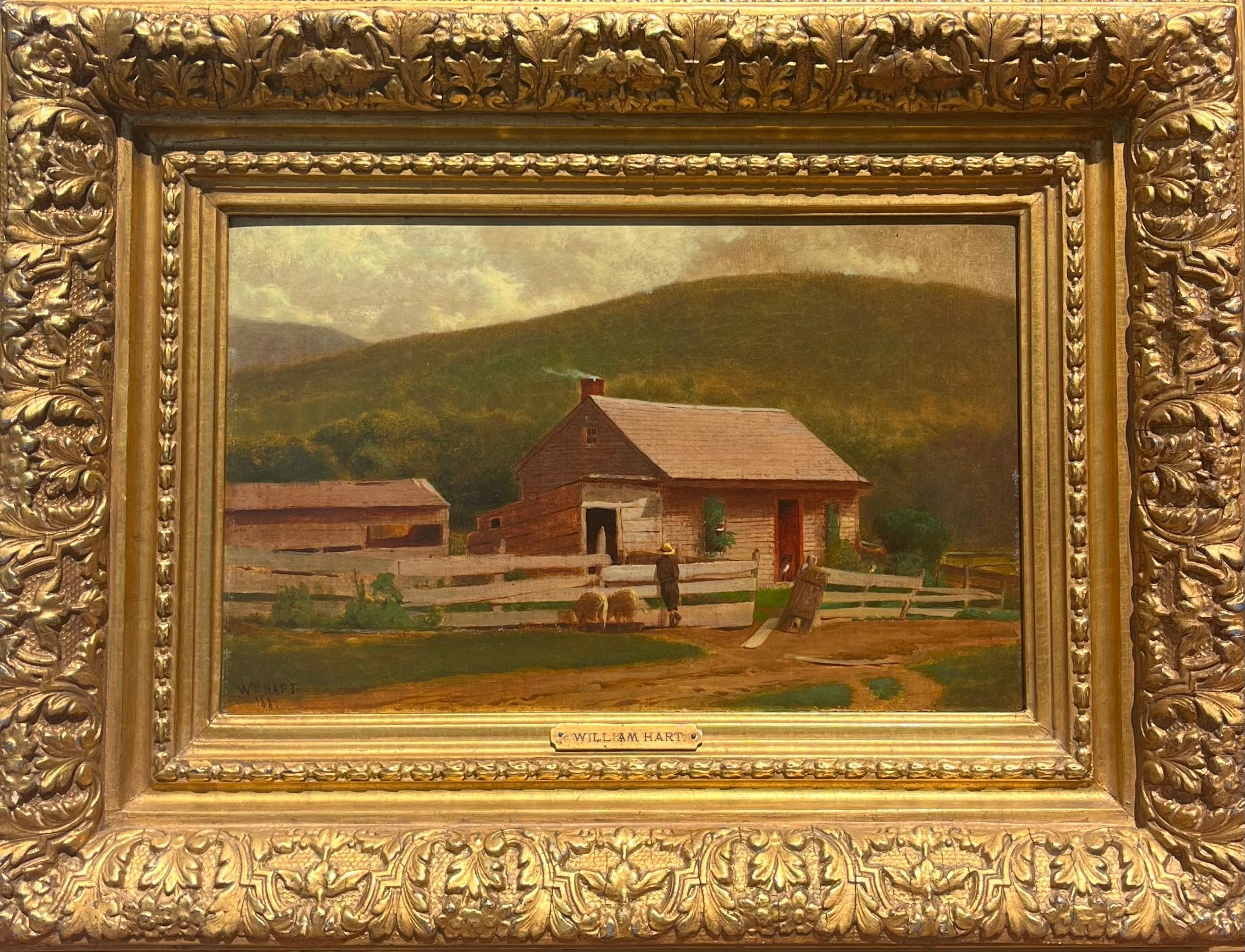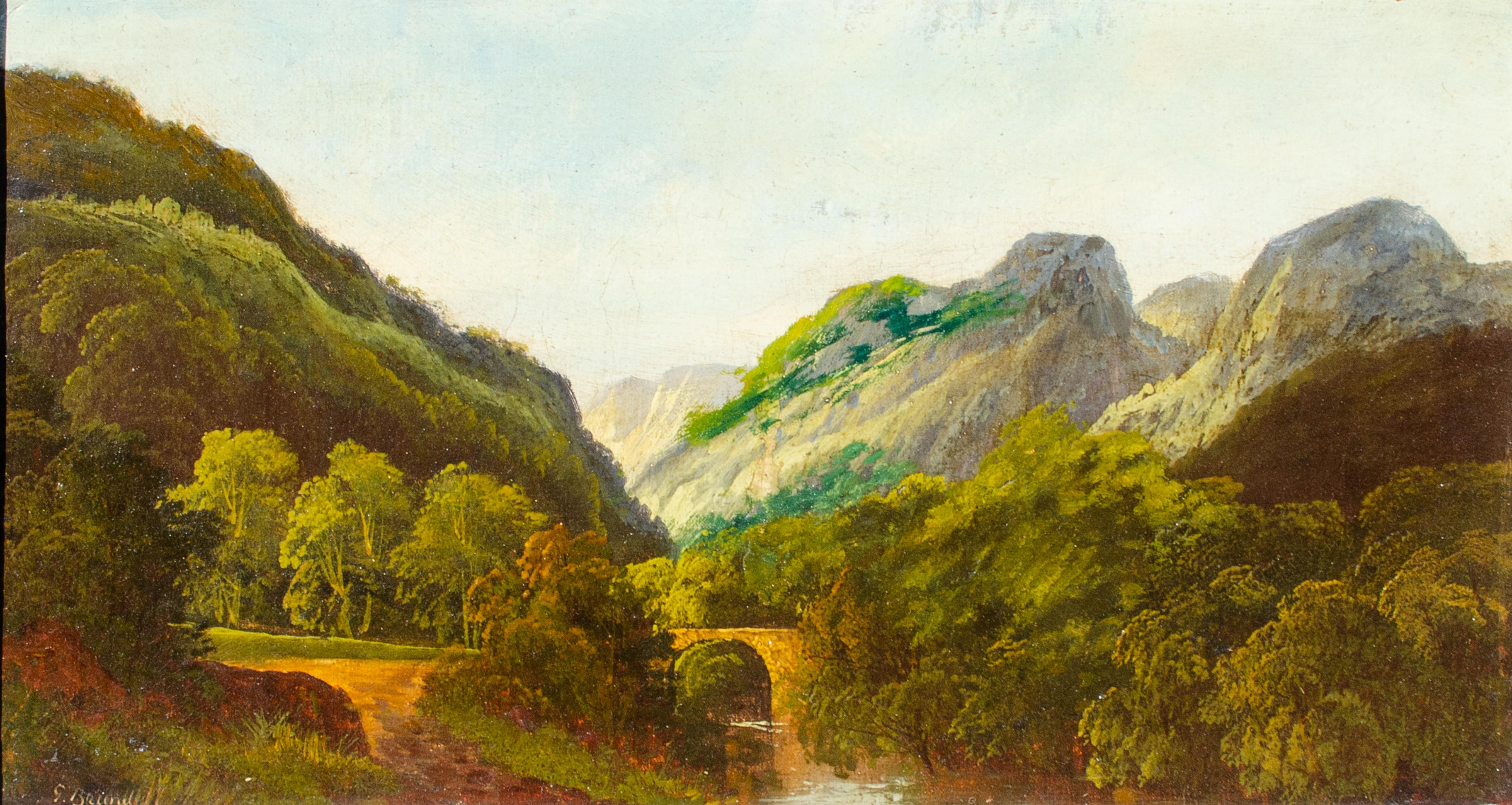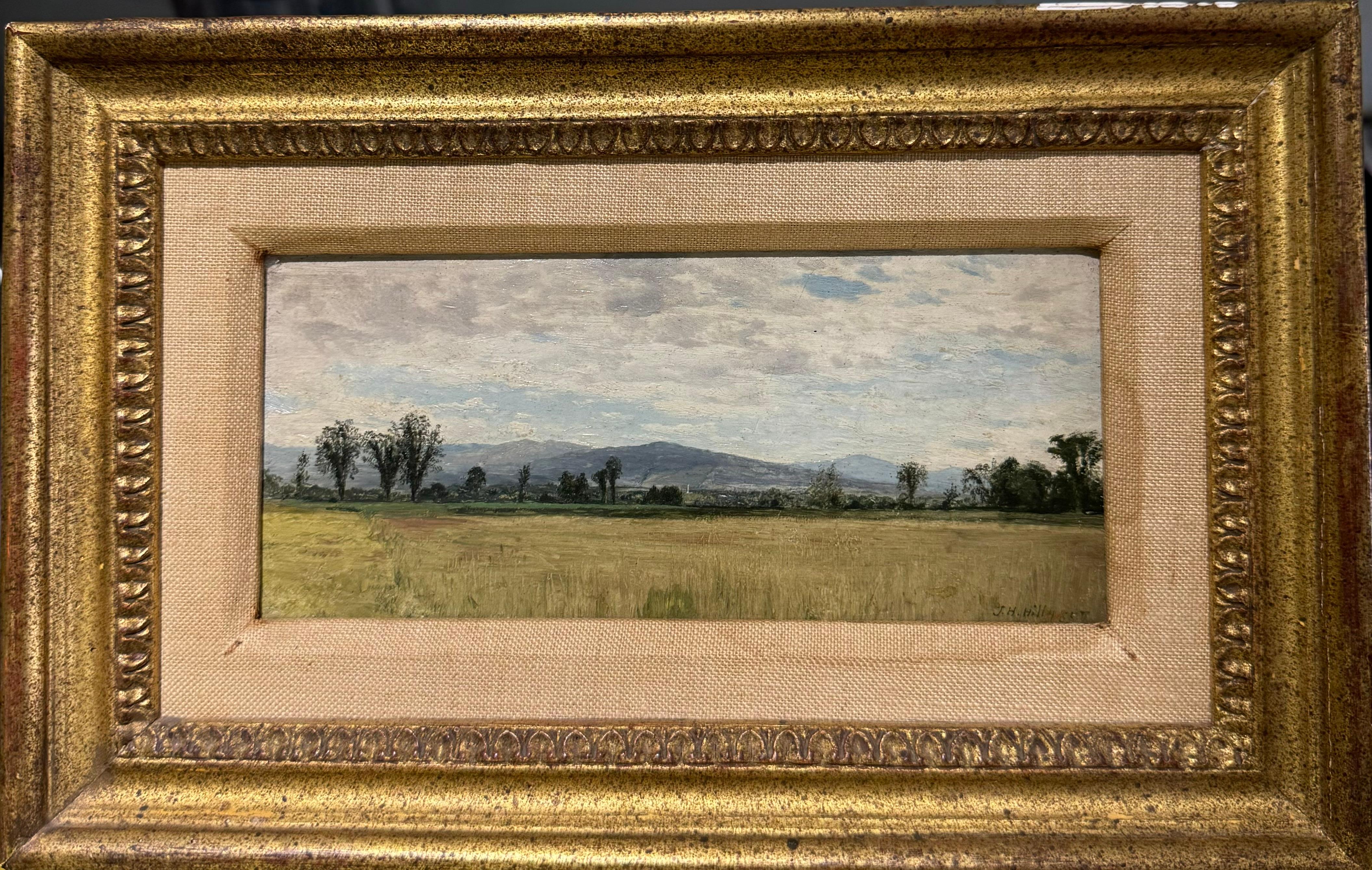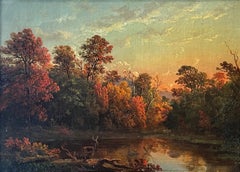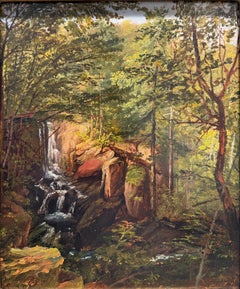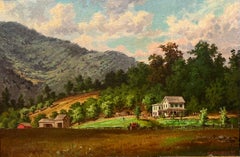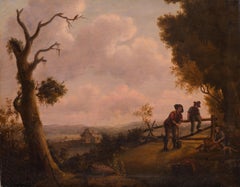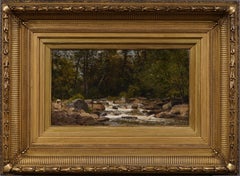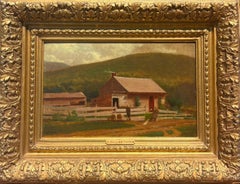Items Similar to "Building the Allegheny Railroad, Pennsylvania" Alfred Wall, Scalp Level School
Want more images or videos?
Request additional images or videos from the seller
1 of 7
Alfred S. Wall"Building the Allegheny Railroad, Pennsylvania" Alfred Wall, Scalp Level School1859
1859
$22,500
£17,048.02
€19,561.25
CA$31,661.13
A$34,804.29
CHF 18,291.54
MX$422,650.89
NOK 228,182.37
SEK 216,186.75
DKK 145,990.55
About the Item
Alfred S. Wall (American, 1825-1896)
Untitled (Building the Railroad), 1859
Oil on canvas
14 1/2 x 18 1/2 inches
Signed and dated lower left
For Christmas, 2008, the Pittsburgh Post-Gazette featured Alfred Wall's painting, Old Saw Mill from the collection of the Westmoreland Museum of American Art in Greensburg, PA. It was painted in 1851 in the town of Lilly, Pennsylvania in the Allegheny Mountains. The newspaper description stated that "though the saw mill is long gone, it still conveys all the warmth and coziness of this time of year. The article, written by Patricia Lowry, continued:
At first glance, Alfred S. Wall's painting of a saw mill in snowy woods triggers nostalgia for the coziness of a log cabin, the smell of a wood-burning fire and the warming of chilled hands and feet beside it.
But as sentimental as it seems on the surface, Mr. Wall's painting has a deeper and unexpected context.
This is more than a painting about sled-riding children and early industry planted in the middle of virgin forest. Intended or not, this is a painting about conquering the great divide of the Allegheny Mountains.
For the third consecutive year, the Post-Gazette features a winter-scene painting on the cover of the Christmas Day newspaper. This year's painting, Old Saw Mill, was selected by co-publisher and editor-in-chief John Robinson Block and executive editor David Shribman during a visit to the Westmoreland Museum of American Art in Greensburg.
Mr. Wall, listed as a portrait painter in the 1850 census, was about 26 when he painted Old Saw Mill in 1851. The self-taught artist was born in Mount Pleasant, Westmoreland County, to William and Lucy Wall, who'd emigrated from England around 1820. An artistic sensibility ran in the family: William was a sculptor who carved ornate tombstones here; Alfred's children, A. Bryan and Bessie, were landscape painters, as was Alfred's older brother, William Coventry Wall. For more than a century the Walls formed a prominent art dynasty in Pittsburgh, and Alfred, eventually a partner in the city's most prestigious art gallery, was well known as a painter, dealer and restorer.
In Old Saw Mill, two wood cutters, each holding an axe, meet outside the mill; one points in the direction of the forest. On the other side of the stream, one child pulls another down the hillside on a sled. Just behind the hill's slope, the roof of a building appears, perhaps the home of the sawyer. The luminous, late afternoon light comes from the northwest, casting lengthening shadows on the snow under a darkening sky.
The saw mill in "Old Saw Mill" likely would have been impossible to track down had Mr. Wall, presumably, not written on the back of the painting: "old saw mill near Jct. 4, Portage RR, Pa."
"There was no Junction 4," said Mike Garcia, park ranger at the Allegheny Portage Railroad National Historic Site, about 90 miles east of Pittsburgh near Gallitzen, Cambria County. "But there was an Inclined Plane No. 4 at Lilly, and there was a saw mill there."
In fact, there were at least six saw mills at Lilly over the years, said longtime resident Jim Salony, president of the Lilly-Washington Historical Society. But when he saw an image of the painting, Mr. Salony had no trouble coming up with a location. While there are no known photographs of the saw mill, he believes it stood near the intersection of Portage and Washington streets, next to Bear Rock Run.
Mr. Salony, retired academic dean at Mount Aloysius College, didn't know exactly when the mill was torn down, but it's been gone since at least the late 1800s. He was pleased to learn of the painting, even though that knowledge came too late for inclusion in a new book about Lilly, The Spirit of a Community, for which he served as primary author and editor. It runs to more than 700 pages. For a little town -- population 869 last year -- Lilly has a lot of history.
Nestled in a bowl on the western slope of the Allegheny Mountains about 3 miles south of Cresson, Lilly was first settled in 1806 by Joseph Meyer and his family, who named their 332-acre land patent Dundee. Although the Meyers had left by 1811, other settlers followed, but the community didn't flourish until the 1830s, when the Allegheny Portage Railroad began its 23-year-run through the town.
For 200 years the Alleghenies had stood as an impediment to trade and travel between Pittsburgh and the east. A canal from Philadelphia to Pittsburgh would change that and compete with New York's Erie Canal. But a portage railroad would have to be built, on which teams of horses would lead the canal boats over the mountains. Engineer Sylvester Welch began his surveying from the small settlement at Lilly. The railroad would require 10 inclined planes, some quite steep, between Hollidaysburg and Johnstown. To build it, trees had to be cut along a 120-foot-wide right-of-way for 36 miles, along which track and engine houses had to be built.
William Brown, who owned the saw mill on Bear Rock Run, built at least one of the engine houses at Inclined Plane No. 4; an 1834 contract also included fencing the dwelling lots at the head and foot of the plane. Lilly is located at what was the foot of Inclined Plane No. 4., giving the community one of its early informal names, Foot of Four.
Named in 1883 for Richard Lilly, who'd completed the grist mill there, Lilly had another early name: Hemlock, so dubbed by a Portage Railroad traveler who smelled the bark stripped from the trees at the saw mill.
Because there isn't another Allegheny Portage Railroad location like it, where a cut in the mountains opens into a bowl, Mr. Salony thinks it was Lilly that Charles Dickens wrote about following his trip from Harrisburg to Pittsburgh on the Pennsylvania Canal in late March 1842, describing what he saw after emerging from "the bottom of the cut": "It was very pretty while traveling, to look down into a valley full of light and softness, catching glimpses through the tree-tops of scattered cabins; children running to the doors; dogs bursting out to bark, who we could see without hearing; terrified pigs scampering homeward; families sitting out in their rude gardens; cows gazing upward with a stupid indifference; men in their shirt-sleeves looking on at their unfinished houses, planning out to-morrow's work; and we riding onward, high above them, like a whirlwind."
To get to Lilly, Mr. Wall may have taken the Pennsylvania Canal from his home in Allegheny City, now the North Side. He'd married young, at 21, to Sarah Carr in 1846, the same year he began his career as an artist. By 1880 they were living in a brick townhouse at 104 (later 814) Arch St., now demolished.
Across the river in Pittsburgh he shared a studio at 67 Fourth Ave. with his brother William; they later moved to Burke's Building, today the city's oldest office building at 209-211 Fourth. But often they worked outdoors, sometimes as part of the colony of artists that grew up around painter George Hetzel beginning in the late 1860s at Scalp Level, just south of Johnstown.
The Walls are featured prominently in the Westmoreland Museum's current exhibit, "Scenic Views: Painters of the Scalp Level School Revisited," through Feb. 1. Scalp Level provided "all the landscape elements a painter might desire," writes museum director Judith Hansen O'Toole in her introductory essay: streams, waterfalls, forest interiors, farms, country lanes, orchards and meadows. It also provided the themes important to a 19th-century landscape painter, including man versus nature.
But the mill in Old Saw Mill, on view in the museum's lobby but not part of the Scalp Level show, seems more like a picturesque interlude in a pristine landscape than a threatening intrusion.
Last year, 29 Wall paintings were given to the museum by Betty Jane McWilliams, whose great-grandmother, Helen Wall McClure, was Alfred S. Wall's sister. While none is in the current exhibit, they'll be featured beginning Feb. 22 in a new show, "The Gift of Art," highlighting gifts to the museum.
Dr. McWilliams, University of Pittsburgh Professor Emerita, inherited some of the paintings and collected the rest, mostly through galleries, dealers and auctions in Western Pennsylvania.
"[The portraits and landscapes] were family history," Dr. McWilliams said. "I kept hearing about them and seeing them even when I was little. You can't have these people staring down at you all your life and not be interested."
Pitt published her 24-page illustrated monograph The Four Walls, drawing on her own and others' research, in 2001.
Old Saw Mill, which measures 38 inches by 57 inches, came into the collection via galleries in New York and Philadelphia. Its earlier provenance and exhibition history are unknown.
"It's of a size that it was probably done for exhibition," said Ms. O'Toole.
Mr. Salony thinks the large log across the stream at the bottom of the painting was part of temporary dams the sawyers built to hold back water for a strong release that would float the logs down Bear Rock Run.
"Always tell the truth in your work" was the artist's motto, Dr. McWilliams reports.
But truth is relative. In the lower left of the canvas, Mr. Wall winks at his audience by signing his name along the length of another log and painting the year on a nearby stone.
The Allegheny Portage Railroad was in use until 1857, when the Pennsylvania Railroad was completed. Today, near where the saw mill stood, a church and houses flank Bear Rock Run just before it flows under Portage Street, once the bed of the first railroad to cross the Alleghenies.
- Creator:Alfred S. Wall (1825 - 1896, American)
- Creation Year:1859
- Dimensions:Height: 21 in (53.34 cm)Width: 25 in (63.5 cm)
- Medium:
- Movement & Style:
- Period:
- Condition:
- Gallery Location:New York, NY
- Reference Number:1stDibs: LU1841210652602
About the Seller
5.0
Platinum Seller
Premium sellers with a 4.7+ rating and 24-hour response times
Established in 2022
1stDibs seller since 2022
122 sales on 1stDibs
Typical response time: <1 hour
- ShippingRetrieving quote...Shipping from: New York, NY
- Return Policy
Authenticity Guarantee
In the unlikely event there’s an issue with an item’s authenticity, contact us within 1 year for a full refund. DetailsMoney-Back Guarantee
If your item is not as described, is damaged in transit, or does not arrive, contact us within 7 days for a full refund. Details24-Hour Cancellation
You have a 24-hour grace period in which to reconsider your purchase, with no questions asked.Vetted Professional Sellers
Our world-class sellers must adhere to strict standards for service and quality, maintaining the integrity of our listings.Price-Match Guarantee
If you find that a seller listed the same item for a lower price elsewhere, we’ll match it.Trusted Global Delivery
Our best-in-class carrier network provides specialized shipping options worldwide, including custom delivery.More From This Seller
View AllRapelyea House, New York, William Rickarby Miller, Hudson River School Landscape
By William Rickarby Miller
Located in New York, NY
William Rickarby Miller
Rapelyea House, New York, 1884
Signed and dated lower left
Oil on canvas
20 x 30 inches
Provenance:
Kennedy Galleries, New York
Born in Staindrop, County Durham, England, he was a portrait and landscape painter, especially appreciated for watercolor painting, which he sold through the American Art Union...
Category
1880s Hudson River School Landscape Paintings
Materials
Canvas, Oil
"Sunset, Indian Summer" DeWitt Clinton Boutelle, Hudson River School Landscape
Located in New York, NY
DeWitt Clinton Boutelle
Sunset, Indian Summer, 1848-49
Signed and dated lower left
Oil on canvas
12 x 16 inches
DeWitt Clinton Boutelle was b...
Category
1840s Hudson River School Figurative Paintings
Materials
Canvas, Oil
"Janetta Falls, New Jersey" Jasper F. Cropsey, Hudson River Wooded Landscape
By Jasper Francis Cropsey
Located in New York, NY
Jasper F. Cropsey
Janetta Falls, New Jersey, circa 1846
Signed J.F. Cropsey
Oil on canvas
12½ x 10¾ inches
Provenance
Private Collection, New York, 1930s
Thence by descent to the pr...
Category
1840s Hudson River School Figurative Paintings
Materials
Canvas, Oil
"West Point" John Ferguson Weir, Hudson River School Landscape with Sailboats
By John Ferguson Weir
Located in New York, NY
John Ferguson Weir
West Point, 1873
Signed and dated lower left
Oil on panel
12 1/8 x 20 1/8 inches
Provenance:
Sotheby's Arcade, American Paintings, December 19, 2003, Lot 1091
Spanierman Gallery, New York
Private Collection, New York (acquired directly from the above)
Exhibited:
Roslyn, Nassau County Museum of Fine Art, William Cullen Bryant, The Weirs and American Impressionism, April 24, 1983-July 31, 1983.
A painter, sculptor, writer, and teacher, John Weir was a highly talented man whose painting was overshadowed by his father, Robert Weir, the long-time West Point Academy drawing teacher, and his brother, J Alden Weir, well-known impressionist painter.
His distinguished reputation was primarily based on his accomplishments as a teacher and administrator. For many years, from 1869 to 1913, John Weir was the Director of the Yale University School of Fine Arts. He was also a commissioner of the art exhibition at the Centennial Exposition in Philadelphia.
Weir was born at West Point, New York, and by age 20, had a studio in New York City in the Tenth Street Studio Building, the first building in America dedicated to art studios, and there he associated with many leading painters of the day.
He earned attention early in his career for paintings of industrial scenes...
Category
1870s Hudson River School Landscape Paintings
Materials
Oil, Panel
"East Hampton, New York" George Henry Smillie, Hudson River School, Long Island
By George Henry Smillie
Located in New York, NY
George Henry Smillie
East Hampton, New York, 1884
Signed lower left
Dated lower right
Oil on canvas
15 x 24 inches
Provenance
Cigna Museum and Art Collection
Questroyal Fine Art
T...
Category
1880s Hudson River School Figurative Paintings
Materials
Canvas, Oil
"Grand Manan" Harrison Bird Brown, Maine Landscape, Hudson River School Seascape
By Harrison Bird Brown
Located in New York, NY
Harrison Bird Brown (1831 - 1915)
Grand Manan
Oil on canvas
12 x 20 inches
Signed with initials lower left
Harrison Bird Brown was born in 1831 in Portland, Maine, and is best known for his White Mountain landscapes and marine paintings of Maine's Casco Bay...
Category
Late 19th Century Hudson River School Landscape Paintings
Materials
Canvas, Oil
You May Also Like
House in the Mountains of Upstate New York
Located in Fredericksburg, VA
"Little House in the Upstate New York Mountains" by C.H. Schmidt is a captivating painting that evokes a sense of rustic charm. Set against the backdrop of the majestic mountains of ...
Category
Late 19th Century Hudson River School Landscape Paintings
Materials
Canvas, Oil
Rural Scene 1850, A view of Concord in the distance from Tilton, NH
Located in North Clarendon, VT
Fantastic early New Hampshire landscape by John Rollin Tilton. Pre White Mountain School. View from Tilton NH looking back towards Concord. Oil on canvas - deserves a special place o...
Category
1850s Hudson River School Landscape Paintings
Materials
Oil
Antique American Hudson River School Scalp Level Pennsylvania Landscape Painting
Located in Buffalo, NY
Impressive early American Hudson River School landscape oil painting by Jasper Holman Lawman (1825 - 1906). Framed. Oil on board. Signed. Image size, 10H by 16L.
Category
1870s Hudson River School Landscape Paintings
Materials
Oil, Board
Oil Landscape of Cabin In the Mountains
By William Hart
Located in Fredericksburg, VA
William Hart was an influential figure in the art world, best known for his contributions as a landscape painter during the 19th century. Born in Paisley, Scotland, in 1823, Hart imm...
Category
Late 19th Century Hudson River School Landscape Paintings
Materials
Canvas, Oil
Hudson River School Style Painting, Signed Brundell
Located in New York, NY
G. Brundell
Untitled, c. Early 20th Century
Oil on canvas
Sight: 10 x 18 in.
Framed: 19 7/8 x 27 7/8 x 2 in.
Signed lower left
Category
Early 20th Century Hudson River School Landscape Paintings
Materials
Oil, Canvas
1857 American Hudson River Rockland County Landscape Painting KENNEDY Gallery
By John Henry Hill
Located in New York, NY
John Henry Hill
1839-1922
Signed lower right
Dated: 1857
Sight size: 3 3/4 x 7 1/2 inches
Overall size: 7 3/4 x 11 1/2 inches
oil on panel
Good condition
Kennedy Gallery Label Verso
...
Category
1850s Hudson River School Landscape Paintings
Materials
Wood Panel
More Ways To Browse
Antique Level
Antique Railroad
19th Century Western Oil Paintings
19th Century Landscape With Cows Oil Painting
Canal Boats
Hand Carved Wood Horse Head
19th Century Virgin Oil Paintings
The Old Mill
Antique Sleds
The Day The Wall Came Down
Antique Fencing
Antique Tombstone
Dundee Antique
Oil Painting Pennsylvania
Cows In A Stream Painting
Pennsylvania Railroad
Pennsylvania Landscape Painting
Hand Carved Wood Rocking Horse


